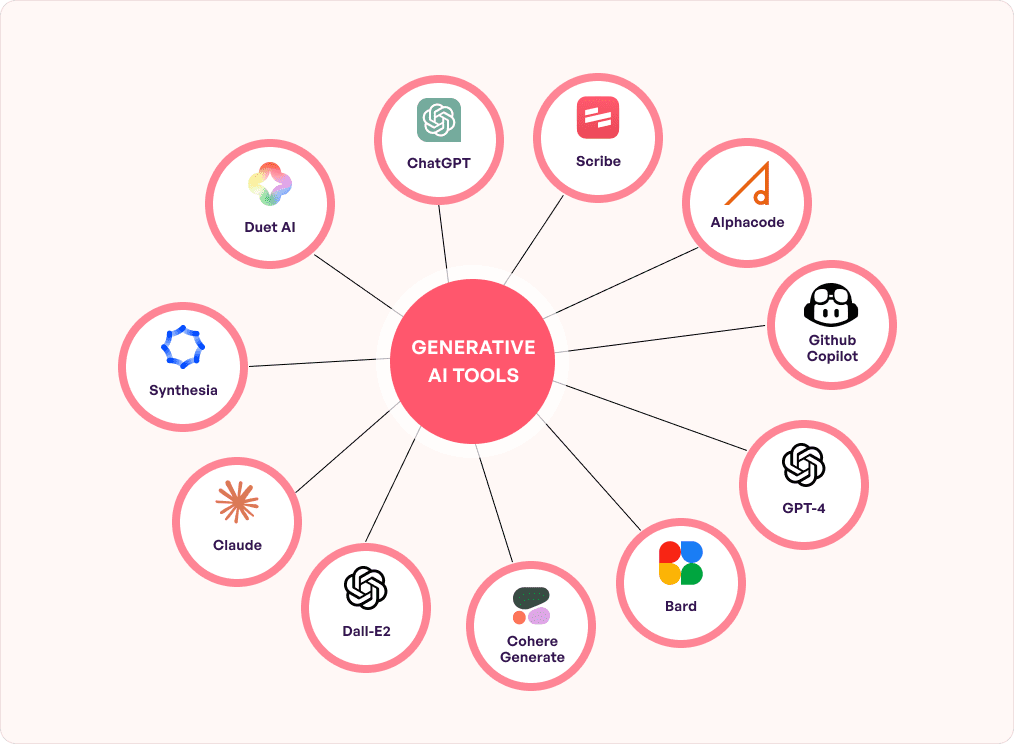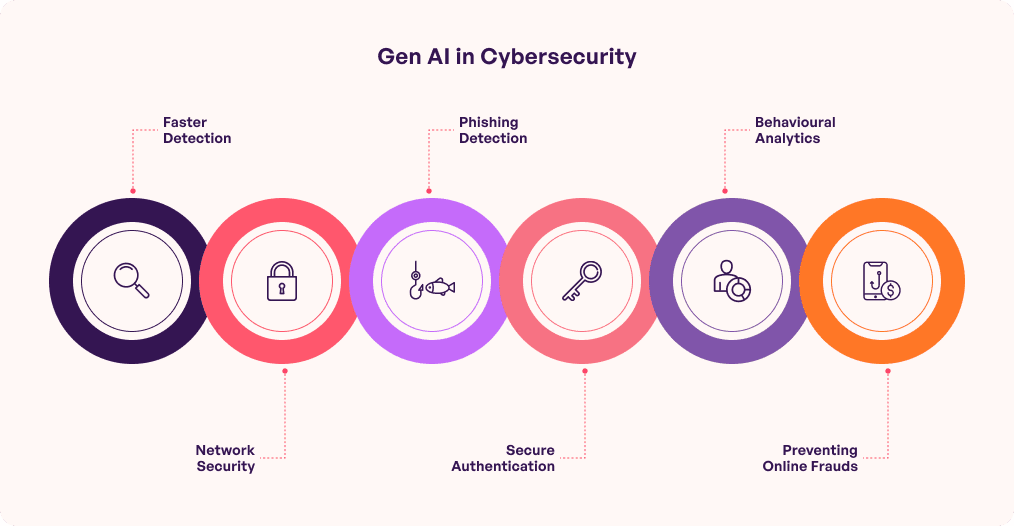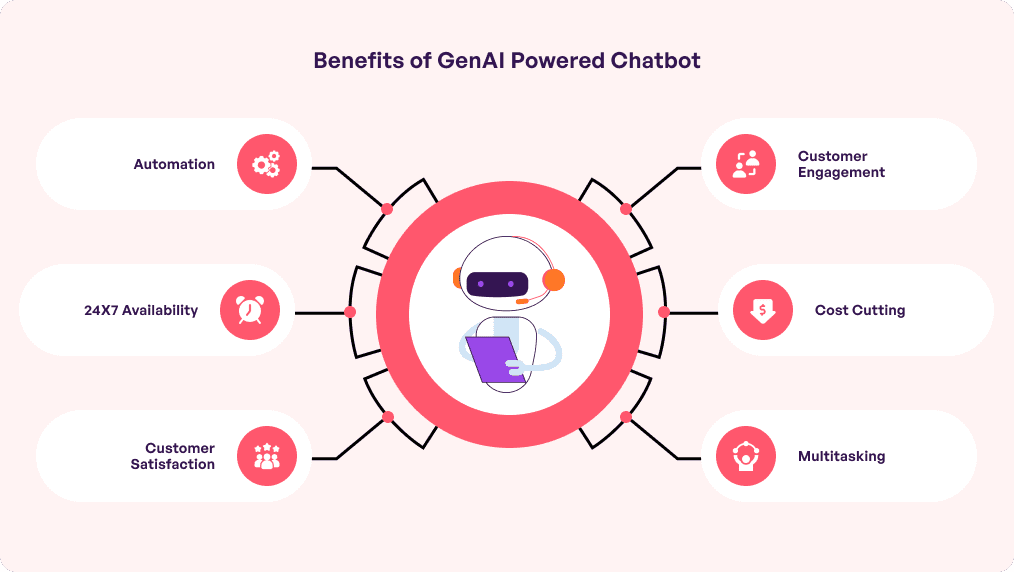AI is all-pervasive in every walk of life. Among its many domains, generative AI has emerged as a groundbreaking transformative force. One of its first functioning products was ELIZA chatbot. It then became popular around 2006 but the term first appeared in a paper called ‘A Fast Learning Algorithm for Deep Beliefs Nets’ by Geoffrey Hinton.
However, it was not until a decade later that generative AI could create convincing audio, video, and images of real people. Now in 2024, J.P. Morgan Research estimates that GenAI has the potential to boost global GDP by $7 trillion to $10 trillion or 10%. Wondering how?
Well, modern GenAI is based on deep learning. This is extremely helpful, especially in the workforce since the technology imitates the way the human brain thinks.
This helped it cause an impressive surge in human workforce productivity which will ultimately regulate the economic cycle. Generative AI technology will revolutionize adoption of generative conversational AI for customer services which allows enterprises to reduce the costs of support agents and other activities by up to 30%. Other applications of generative AI in the workplace include automated content production, translating technical content, data insights, and routine task automation.
 In short, it is a game changer in the business landscape! Noting that, now would be the perfect time to dive into the top trends in generative AI to be ahead of the curve in leveraging technologies.
In short, it is a game changer in the business landscape! Noting that, now would be the perfect time to dive into the top trends in generative AI to be ahead of the curve in leveraging technologies.
Table of contents
Cybersecurity solutions
Cybersecurity measures help your business grow without reputational and financial losses. See how. Embedding generative AI strengthens the process by protecting against AI- generated threats and helps deal with sensitive data better. Generating security patches and highly enhanced biometrics with fingerprint templates and face recognition patterns is further a rising generative AI market trend. It helps avoid data breach and stolen intellectual property. Further, GenAI does the following incredibly well:
- analyzing large volumes of data
- adapting to new personalized threat strategies, and
- detecting sophisticated phishing attempts.
 In a nutshell, using generative AI technology is putting your money to good use since it keeps businesses safe online. Additionally, GenAI-driven cybersecurity and legal compliance go hand-in-hand to avoid penalties and similar repercussions. These factors are expected to drive the market for AI in cybersecurity to reach roughly $134 billion by 2030.
In a nutshell, using generative AI technology is putting your money to good use since it keeps businesses safe online. Additionally, GenAI-driven cybersecurity and legal compliance go hand-in-hand to avoid penalties and similar repercussions. These factors are expected to drive the market for AI in cybersecurity to reach roughly $134 billion by 2030.
Smart companionship
GenAI powered smartphone assistants are all set to enhance communication like never before. The multimodal systems will be able to learn from your daily activities and provide highly personalized solutions to ease your life. This is one of the coolest generative AI trends as this personal bot will turn into an ‘indispensable companion’ and redefine the way you interact with multiple apps. They will come with the ability to match texts with related videos and images. The best part is that the bots will be able to generate original content as well that they picked from the training model. Engage in conversations or ask for real-time data – the AI chatbot will combine and generate data while adapting to different tasks.
Further, tech firms like yours can develop a skillful personal assistant for their customers. It will offer round-the-clock, multilingual and fast support. This will increase the chances of more leads and better sales.
Creativity
One of the most current trends in the generative AI space is that outputs are ‘traditionally considered creative’ rather than predictive. This is because the system focuses on creating original content prioritizing perplexity, novelty, and diversity. Here’s proof. A 2024 report published by Oxford Academic shows that Gen AI’s text-to-image abilities can enhance human creative productivity by 25%. As a business, expect high-quality animation, tunes, and audio in your app since the best developers harness the possibilities of GenAI.
Generative AI can be used in diverse industries like finance and healthcare. This is exactly what Simublade does. Our team engineers expert generative AI solutions to build functional apps with the aim of boosting automation and operational excellence. We also use artificial intelligence solutions in verticals like web development, cloud strategy, and software development. Chances are, while you are reading this, a fellow entrepreneur might already be getting own GenAI tool. So, take time to learn more about AI services to get yours built.
3D content generation
GenAI has transformed the way 3D content is created and navigates the challenges that come with it. Creators, designers, and advertisers can turn texts into powerful 3D versions within no more than a minute. The future of generative AI-based content is promising with advancements in Generative Adversarial Networks (GANs) and diffusion models.
GAN creates image-based content by applying a ‘generator and a discriminator’. On the other hand, diffusion models are equipped with latent variables that create content by removing noise (blur) from datasets. This helps create brand new images on the theory of concept abstraction.

Hyper-personalization
Generative AI is a subset of artificial intelligence. Yet it has quite a few fundamental differences, for instance, it can be applied to music generation and graphics, unlike conventional AI. This brings us to another interesting generative AI industry trend called hyper-personalization. It means a 360° customer-view which helps create top-notch personalized content. The process is driven by AI algorithms and resonates extremely well with individual preferences. Ultimately, it leads to enhanced customer satisfaction, higher customer lifetime value, and a reduction in bounce rate. These encourage better conversions and sales.
Moving to the essential components of hyper-personalization that can be achieved by GenAI:
- data analysis
- data collection
- customer-journey mapping
- testing and optimization, and
- security and privacy.
GenAI leverages these factors to attain once-impossible personalization levels. For example, it can adjust behavioral data based on demographics, psychographics, sentiment analysis, interactions, and transaction history. Real-time data is further maximized to tailor highly relatable content. This extends beyond the traditional experience by leveraging advanced techniques and technologies. All of these promises improved user loyalty and competitive differentiation.
Server shift
In 2023, GenAI tools helped reduce cloud migration time by 30-40%. However, the next-level AI experience will be on devices altogether, cutting the need for cloud. This means, large multimodal AI models will shift from cloud to hybrid or on-device platforms. This is quite possible since GenAI systems can easily shrink down to fit any size. It is a necessary change to ensure transparency, privacy and protection for cost-sensitive data.
Multimodal system
Google’s Gemini is the latest advancement when it comes to generative AI technology trends shifting towards multimodality. It is a cutting-edge technology that ‘mirrors human perception.’ GenAI multimodal systems have the potential to revolutionize several sectors like agriculture, healthcare, fintech, and e-commerce. But what is multi-modality? In simple terms, a few GenAI systems are structured to provide diverse outputs like images, audio, videos, and texts from inputs like images, audio, videos, and verbal prompts. This offers a multisensory experience while readers are never limited to a single solution. Multimodal GenAI is based on three core components:
- Input module – It contains neural networks that process particular data.
- Fusion module – Data streams from the previous module are combined into a dataset for a detailed understanding.
- Output module – This is where the multimodal responses are generated. It includes image creation from 3D visuals, text prompts, and video content summaries.
 Multimodal generative intelligence is far advanced from traditional AI systems that are single-mode and trained on specific data types. No wonder, it is the next big leap which refines natural interaction, heightens precision, improves AI system capabilities, and elevates contextual understanding.
Multimodal generative intelligence is far advanced from traditional AI systems that are single-mode and trained on specific data types. No wonder, it is the next big leap which refines natural interaction, heightens precision, improves AI system capabilities, and elevates contextual understanding.
Compliance
A few challenges of regulatory compliance include data management, cross-border operations, and human error. The good news is that GenAI can address these by ensuring automated regulatory monitoring, natural language processing, document analysis, and creating compliance policies and procedures, be it healthcare, fintech or any other industry. This is one of the most evergreen generative AI trends that is likely to stay and help navigate legal and ethical considerations.
Be it fintech, healthcare, or similar businesses, GenAI can automate, enhance, and accelerate every industry. It will help enterprises be compliant with laws, privacy regulations, and standards. Thus seizing the promising benefits of generative intelligence, every business can align customer requirements and revenue.
Supercycle
A supercycle in traditional computers is anticipated in the second half of 2024. Laptops might be replaced with intelligent PCs and desktops with AI assistants due to their groundbreaking advancements with GenAI. The surge would be due to on-device generative AI abilities like real-time speech translation and transformation from texts to images.
PCs will also process other AI tasks like fraud detection and data entry. Altogether, it will streamline daily workflow and ensure superior decision-making with minimal errors. These are a fantastic way to remove barriers, be it communication or product satisfaction, between businesses and their customers.
Conversational AI
This is one of the most exciting and current trends in the generative AI world. ChatGPT had made its debut with a system based out of GenAI. The conversation back then was about generating poems, articles, essays, and news reports. Now, chatbots can process both visual information and language without hiccups. Businesses leverage this system since GenAI ensures a bot can handle multiple conversations 24×7. This aids in serving both global and local customers tirelessly. No wonder, 38% of 2,500 executives of a recent Gartner poll said that customer retention is one of the top purposes of using GenAI.
Other areas where GenAI has penetrated include content augmentation, text and tone manipulation, categorization, simplification, and auto summarization. It further has a key role to play in code generation, legacy code modernization, and product designing.
GenAI wearables
Fitbits, Alexa, and Apple watch have already leveraged this vertical. But generative AI technology has a long way to go. It is all set to create advanced sports and health wearables that offer real-time instructions and feedback. This is done by tracking using movement with sensors to detect fitness, fatigue, and stress levels. Users can also get an idea of the intensity of training and if they would require rest. In no time, these devices will enter the market and slowly emerge as your personal friend, advisor, trainer, and guide.
Intelligent process automation
GenAI tools are on the rise to boost automation to ensure quick and effective business operations. This will reduce the need for human intervention in tedious routine tasks. The process will combine OCR, analytics, RPA with process mining, and of course, GenAI to create systems that can learn and adapt. In short, the brain of AI and the muscle of automation can reshape even the most complex business processes.
The future of generative AI
Generative AI is predicted to shorten the road to human-level performances. This is because it will have an impact in both realms – consumers and creators. In the near future, it is expected to create apps that target particular industries to add more value to customers than the generic ones. A Gartner study already found that more than 50% of GenAI models will be specific to a business function or industry which is 1% as of April 2024.
Overall, it will lead to highly sophisticated foundation models since they are built by utilizing humongous datasets that teach complex patterns to algorithms. For instance, Large Language Models (LLMs) like GPT-4 are based on language processing and machine translation that helps to create content and software code.
GenAI is further expected to penetrate multiple applications like analysis and synthesis, stock image generation, face swaps and adjustment, 3D-object generation, product design and discovery, sound creation, audio editing, text-to-voice generation, and data set generation.
Researchers claim that in a few years, GenAI will help integrate ‘perceptual systems’ by imitating human senses like smell and touch. In fact, it might go beyond what even humans can do -sensing feelings and emotions with electromagnetic signals.
It can revolutionize healthcare systems since changes in a person’s breathing and heart rate can be detected. Altogether, GenAI will emerge as a powerful set of tools that might blur the line between science fiction and reality!
How would you make the best use of this miraculous technology? Well we, at Simublade, are a Texas-based generative AI development company building fail-proof and future-ready solutions. We offer a range of services like AI integration and deployment and AI strategy consulting to name a few. With the right tools, techniques, and technologies, we make sure your software is secure and global. Contact us.
FAQs
Q. What are the latest advancements in generative AI?
Ans. ChatGPT is one of the latest advancements that are on top of the generative AI industry trends. Llama, PaLM, and Bloom are other examples launched in 2022-23.
Q. What is the potential impact of generative AI on industries?
Ans. The potential impacts across all industries are security, automation, innovation, better decision-making, personalization, resource optimization, and compliance. This will lead to a high-quality experience for both customers, employers, and employees. In a nutshell, the future of generative AI is bright indeed.
Q.How can businesses leverage generative AI to stay competitive in 2024?
Ans. Businesses can get GenAI-powered apps built, automate administrative tasks, improve data privacy and security, personalize user experience, integrate GenAI in chatbots, make informed sales and marketing decisions, and create high-ranking content. These applications of generative AI range across diverse industries like travel, healthcare, and fintech to name a few.





